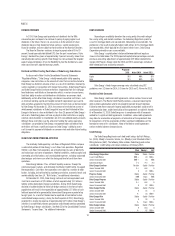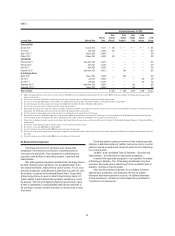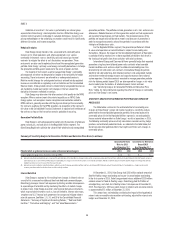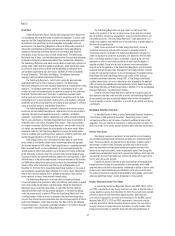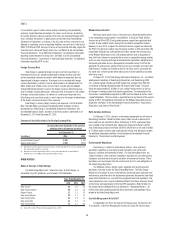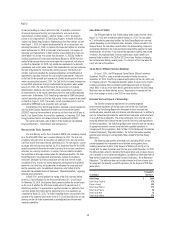Duke Energy 2014 Annual Report Download - page 77
Download and view the complete annual report
Please find page 77 of the 2014 Duke Energy annual report below. You can navigate through the pages in the report by either clicking on the pages listed below, or by using the keyword search tool below to find specific information within the annual report.
57
PART II
Credit Risk
Credit risk represents the loss that the Duke Energy Registrants would incur
if a counterparty fails to perform under its contractual obligations. To reduce credit
exposure, the Duke Energy Registrants seek to enter into netting agreements with
counterparties that permit them to offset receivables and payables with such
counterparties. The Duke Energy Registrants attempt to further reduce credit risk
with certain counterparties by entering into agreements that enable obtaining
collateral or terminating or resetting the terms of transactions after specifi ed
time periods or upon the occurrence of credit-related events. The Duke Energy
Registrants may, at times, use credit derivatives or other structures and techniques
to provide for third-party credit enhancement of their counterparties’ obligations.
The Duke Energy Registrants also obtain cash or letters of credit from customers to
provide credit support outside of collateral agreements, where appropriate, based
on a fi nancial analysis of the customer and the regulatory or contractual terms
and conditions applicable to each transaction. See Note 14 to the Consolidated
Financial Statements, “Derivatives and Hedging,” for additional information
regarding credit risk related to derivative instruments.
The Duke Energy Registrants’ industry has historically operated under
negotiated credit lines for physical delivery contracts. The Duke Energy
Registrants frequently use master collateral agreements to mitigate certain credit
exposures. The collateral agreements provide for a counterparty to post cash
or letters of credit to the exposed party for exposure in excess of an established
threshold. The threshold amount represents a negotiated unsecured credit
limit for each party to the agreement, determined in accordance with the Duke
Energy Registrants’ internal corporate credit practices and standards. Collateral
agreements generally also provide that the inability to post collateral is suffi cient
cause to terminate contracts and liquidate all positions.
The Duke Energy Registrants’ principal customers for its electric and gas
businesses are commodity clearinghouses, regional transmission organizations,
industrial, commercial and residential end-users, marketers, distribution
companies, municipalities, electric cooperatives and utilities located throughout
the U.S. and Latin America. The Duke Energy Registrants have concentrations of
receivables from such entities throughout these regions. These concentrations
of customers may affect the Duke Energy Registrants’ overall credit risk in that
risk factors can negatively impact the credit quality of the entire sector. Where
exposed to credit risk, the Duke Energy Registrants analyze the counterparties’
fi nancial condition prior to entering into an agreement, establish credit limits and
monitor the appropriateness of those limits on an ongoing basis.
Duke Energy Carolinas has a third-party insurance policy to cover certain
losses related to its asbestos-related injuries and damages above an aggregate
self-insured retention of $476 million. Duke Energy Carolinas’ cumulative payments
began to exceed the self-insurance retention on its insurance policy during the
second quarter of 2008. Future payments up to the policy limit will be reimbursed
by the third-party insurance carrier. The insurance policy limit for potential future
insurance recoveries for indemnifi cation and medical cost claim payments is $864
million in excess of the self-insured retention. Insurance recoveries of $616 million
and $649 million related to this policy are classifi ed in the Consolidated Balance
Sheets in Other within Investments and Other Assets and Receivables as of
December 31, 2014 and 2013, respectively. Duke Energy Carolinas is not aware of
any uncertainties regarding the legal suffi ciency of insurance claims. Management
believes the insurance recovery asset is probable of recovery as the insurance
carrier continues to have a strong fi nancial strength rating.
The Duke Energy Registrants also have credit risk exposure through
issuance of performance guarantees, letters of credit and surety bonds on behalf
of less than wholly owned entities and third parties. Where the Duke Energy
Registrants have issued these guarantees, it is possible that they could be
required to perform under these guarantee obligations in the event the obligor
under the guarantee fails to perform. Where the Duke Energy Registrants have
issued guarantees related to assets or operations that have been disposed of
via sale, they attempt to secure indemnifi cation from the buyer against all future
performance obligations under the guarantees. See Note 7 to the Consolidated
Financial Statements, “Guarantees and Indemnifi cations,” for further information
on guarantees issued by the Duke Energy Registrants.
The Duke Energy Registrants are also subject to credit risk of their
vendors and suppliers in the form of performance risk on contracts including,
but not limited to, outsourcing arrangements, major construction projects and
commodity purchases. The Duke Energy Registrants’ credit exposure to such
vendors and suppliers may take the form of increased costs or project delays in
the event of non-performance.
Credit risk associated with the Duke Energy Registrants’ service to
residential, commercial and industrial customers is generally limited to
outstanding accounts receivable. The Duke Energy Registrants mitigate this
credit risk by requiring customers to provide a cash deposit or letter of credit
until a satisfactory payment history is established, subject to the rules and
regulations in effect in each retail jurisdiction, at which time the deposit is
typically refunded. Charge-offs for retail customers have historically been
insignifi cant to the operations of the Duke Energy Registrants and are typically
recovered through the retail rates. Management continually monitors customer
charge-offs and payment patterns to ensure the adequacy of bad debt reserves.
Duke Energy Ohio and Duke Energy Indiana sell certain of their accounts
receivable and related collections through CRC, a Duke Energy consolidated
variable interest entity. Losses on collection are fi rst absorbed by the equity of
CRC and next by the subordinated retained interests held by Duke Energy Ohio,
Duke Energy Kentucky and Duke Energy Indiana. See Note 17 to the Consolidated
Financial Statements, “Variable Interest Entities.”
Based on the Duke Energy Registrants’ policies for managing credit risk,
their exposures and their credit and other reserves, the Duke Energy Registrants
do not currently anticipate a materially adverse effect on their consolidated
fi nancial position or results of operations as a result of non-performance by any
counterparty.
Marketable Securities Price Risk
As described further in Note 15 to the Consolidated Financial Statements,
“Investments in Debt and Equity Securities,” Duke Energy invests in debt
and equity securities as part of various investment portfolios to fund certain
obligations. The vast majority of investments in equity securities are within the
NDTF and assets of the various pension and other post-retirement benefi t plans.
Pension Plan Assets
Duke Energy maintains investments to help fund the costs of providing
non-contributory defi ned benefi t retirement and other post-retirement benefi t
plans. These investments are exposed to price fl uctuations in equity markets
and changes in interest rates. The equity securities held in these pension
plans are diversifi ed to achieve broad market participation and reduce the
impact of any single investment, sector or geographic region. Duke Energy has
established asset allocation targets for its pension plan holdings, which take into
consideration the investment objectives and the risk profi le with respect to the
trust in which the assets are held.
A signifi cant decline in the value of plan asset holdings could require Duke
Energy to increase funding of its pension plans in future periods, which could
adversely affect cash fl ows in those periods. Additionally, a decline in the fair value
of plan assets, absent additional cash contributions to the plan, could increase
the amount of pension cost required to be recorded in future periods, which could
adversely affect Duke Energy’s results of operations in those periods.
Nuclear Decommissioning Trust Funds
As required by the Nuclear Regulatory Commission (NRC), NCUC, PSCSC
and FPSC, subsidiaries of Duke Energy maintain trust funds to fund the costs of
nuclear decommissioning. As of December 31, 2014, these funds were invested
primarily in domestic and international equity securities, debt securities,
cash and cash equivalents and short-term investments. Per the NRC, Internal
Revenue Code, NCUC, PSCSC and FPSC requirements, these funds may be
used only for activities related to nuclear decommissioning. The investments
in equity securities are exposed to price fl uctuations in equity markets. Duke
Energy actively monitors its portfolios by benchmarking the performance of






